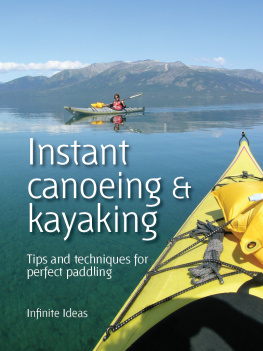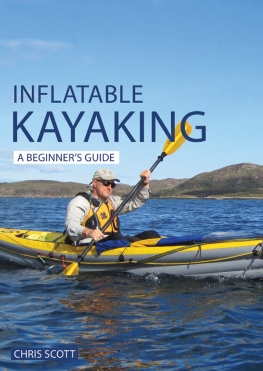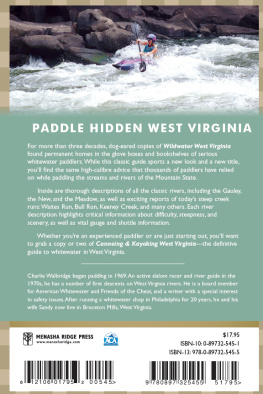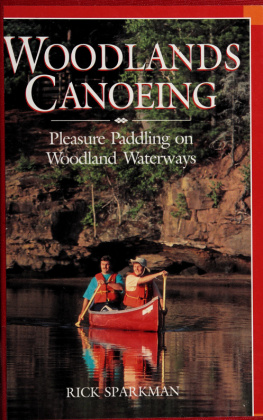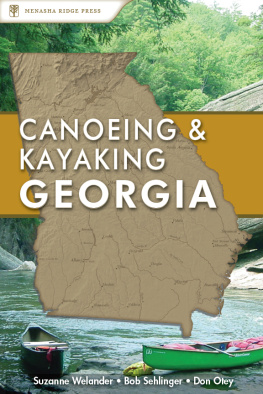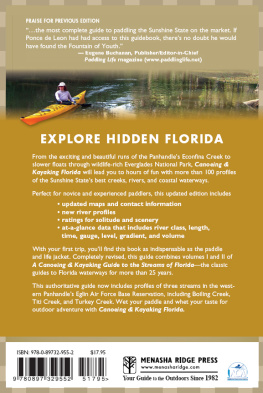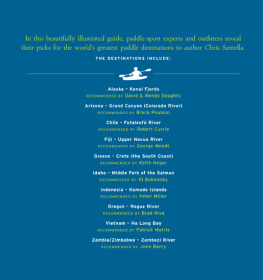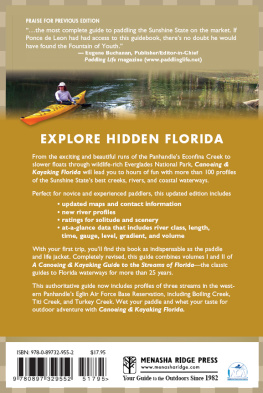An introduction to the two sports
Canoeing and kayaking are two of the oldest forms of transportation on the planet, having been around for thousands of years. Only since the late 1980s, however, has moulding technology made the sports cheap, easy and accessible to everyone. Kayaking and canoeing are all about being one with your boat: as soon as you master the basic skills there is a remarkable freedom to be found in just paddling around under your own steam just inches from the water. You can explore glittering shorelines, race down river rapids, surf giant waves or simply mess about in a lake. Thats the brilliance of these ancient water sports: no matter what it is you do in them, its great. Thats the reason that perfectly normal people, after a session of falling in and out of a canoe for two hours on a November evening, cant wait until their next opportunity to get in the water. Starting with the very basics, this book will talk you through all the different types of kayaking and canoeing available; all the kit; water safety; tips and tricks and how to progress.
1. Clearing up some definitions
In American English, canoe denotes an open-cockpit craft with a one-bladed paddle, while kayak refers to the double-bladed, closed-cockpit boat. Across most of Europe, however, canoe refers to what those speaking American English would call a kayak, and so across Europe a canoe is called a Canadian canoe. These are the terms used by the general population, as those who are actively involved in either sport, either professionally or as a hobby, refer to an open-cockpit boat exclusively as a canoe, and a closed-cockpit boat as a kayak. In the world of canoeing and kayaking, a canoe is an open-topped boat that is control by a paddle with a single blade at the end, by one or two people who are either kneeling or sitting. A kayak is a closed-cockpit boat controlled by a paddle with a blade at either end. To avoid confusion, this book shall from this point refer to an open-topped boat as a canoe, and a closed-cockpit boat as a kayak.
2. Introducing the canoe
Canoes and kayaks have changed a lot in design and appearance since early tribesman first hollowed out trees to cross rivers. The two disciplines share the same goal to propel a craft over water in the simplest way possible. The first proper canoes were developed by Native Americans once they had acquired the necessary tools and skills to construct boats using smaller pieces of wood, instead of just hollowing out a log. The boat is propelled using a single blade while the paddler(s) sit or kneel. As with all watercraft, canoes have a bow (the front); stern (the rear); hull (the bottom) and a deck (the top). There is a handle at either end for carrying the canoe, rescuing it after capsizing, or tying it down to a roof rack. The side of a canoe is referred to as its tumblehome, when its sides curve in. The more curved the sides, the more unsteady the boat feels. However, it is actually less prone to capsizing.
3. Introducing the kayak
The kayak as we know it today was invented by Inuit peoples in Arctic and sub-Arctic regions. It is thought that the single-bladed canoe did not have enough power for the rough seas in which they paddled and hunted. They were made from wooden frames and bones with animal skins stretched over them. Like the canoe, and indeed any other boat, it has a stern, a bow, a hull and a deck. Unique to the kayak, however, is its edge. This is, put crudely, where the top half and bottom half of the kayak are joined, easily visible in a kayak and sitting two or three inches above the water line when the boat is in the water. A kayaks edge is its balancing point lean past this and youll capsize. Getting a feel for the edge, and exploiting it, is key to a lot of the kayak moves and tricks.
4. Different types of kayaks and canoes
There is a lot of variation in the types of canoeing and kayaking available, from racing rapids to exploring the ocean. To suit this, there are many different types of kayaks on the market. If you want to run river rapids and creeks, large, high-volume boats are needed to keep you afloat on the aerated water. You wouldnt want to travel long distances in anything other than an ocean kayak: a long, thin boat designed to cut easily through the water and which provides storage space in the front and back. For tricks and freestyle moves, there are so-called playboats short, stumpy boats with lots of edges to make it easier for the kayaker to do flips and spins. It all makes sense when you think about what you want to do in the boat, and what the boat would have to look like to make it easier. When you first start out youre likely to be in a basic all-purpose kayak. There are really only two types of canoe: the most popular, built for two; or the solo canoe, which is much shorter and taller and designed for doing tricks in whitewater.
5. Entry level kayaking and local clubs
Although kayaking (and sometimes canoeing) is often thought by many to be an extreme sport, this is really only a small part of what its all about. The many different kinds of boats shows theres something for everyone, and you definitely wont be forced to go down any rapids on your first go. As long as there is a relatively large body of water, chances are there will be a water sports activity centre nearby that is more than happy to welcome new kayakers. These clubs will usually have separate groups for adults and children and you will be placed in a group that matches your own ability and confidence. The first one or two sessions are usually free (as the people running them are confident youll like it) and after that there will be a monthly or annual fee. The bottom line here is dont be afraid to join a group! You should never kayak alone, and although youre by yourself in the boat, kayaking is very much a team sport.
6. Level of fitness and water competence
Almost everyone will find kayaking and canoeing difficult and tiring the first time they try it. Even if you consider yourself pretty fit, these sports utilize a lot of muscles that you never really use in any other activity. Because of this, however, your muscles and fitness will adapt very quickly. By your third time out on the water, youll be wondering what all the fuss was about. Something a lot of newcomers worry about is how well they can swim. If this sounds familiar, dont worry, you dont have to be Michael Phelps! All centres and clubs should recommend an ability to swim unassisted for at least 50 metres. You will have plenty of safety equipment and buoyancy aids to help you out when youre actually on the water, but before you try out canoeing or kayaking you should ensure that the minimum swimming requirements are met. Also, it helps if you dont mind the thought of falling in. Although its not a given, its pretty likely on your first time. Enjoy it, the waters lovely.
7. How to improve your fitness
For most enthusiasts, paddling is their main form of exercise, but there are plenty of other sports that supplement the muscles and stamina needed for long days on the water. The fact that boating doesnt exercise the legs is a common concern of many. Although they may not appear to be doing much, your legs actually contribute a lot of power to standard paddling as well as any tricks or rolls where stability is required. Swimming is another all-body workout, and it also has the added benefit of improving your safety when out on the water in a boat. Kayaking relies heavily on back and shoulder muscles, so swimming moves such as the butterfly or backstroke would give added strength. Running and cycling improve leg muscles as well as being good cardiovascular exercise. In fact, any physical exercise will benefit your cardiovascular system and improve your overall performance on the water. A lot of kayakers favour climbing or snowboarding as an alternative sport, perhaps because of a love of all things outdoors. Always make sure to stretch before and after any exercise.
Next page
